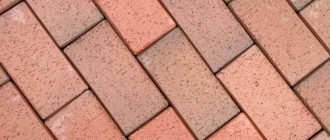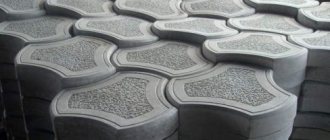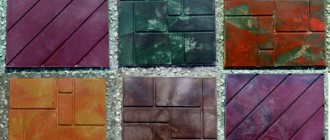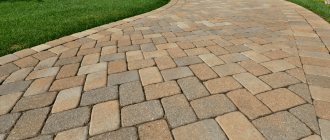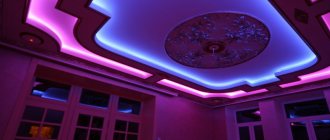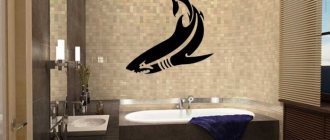There seems to be no limit to human ingenuity and invention. Until recently, it was surprising to see the use of artificial stones or hidden ground irrigation systems in landscape design - heating the soil, providing lush greenery in early spring or late autumn.
Today, against the backdrop of a general revival of interest in the use of energy, luminous paving slabs are incredibly popular, capable of transforming the paths and areas of a dacha or house into some incredible landscape in the evening.
What is a glow tile
Substances capable of accumulating radiant energy and releasing it over a long period of time have been known for a long time and are widely used for marking signs, boundary lines, and even for information boards and traffic signs. Luminous paving slabs have only recently begun to be used in road construction and park landscaping.
To produce luminous paving slabs, several types of light-emitting substances based on a mixture of phosphors are used:
- Fluorescent powders that usually do not accumulate radiation energy, but are capable of re-emitting it. When illuminated with ultraviolet light, they give an even but weak glow;
- Luminescent coatings that accumulate energy from the visible and infrared ranges; luminous tiles accumulate high-energy sunlight best; radiation from incandescent lamps is the worst.
Important! When handled correctly, phosphors do not pose a threat to human health and life.
Quite a lot of luminous substances are known; some mixtures of organic origin can glow not only under the influence of sunlight, but also as a result of chemical reactions, heating, mechanical action, and even radioactive radiation. Not all luminous chemical compounds and substances are safe, like phosphors; many can cause allergies and irritation of the upper respiratory tract. Particularly worth highlighting are phosphorus salts; they are also used in industry, but they cannot be used to prepare luminous paving slabs.
Chemically neutral substances are used to produce luminous coatings with which humans can potentially come into contact. Most often, these are the finest, finely dispersed powders belonging to the fourth hazard class, so when handling powder materials used in the production of luminous tiles, you must be careful and be sure to use latex gloves and a gauze bandage. Once the phosphor powder gets into the varnish or polymer mixture when making a luminous tile coating, it becomes absolutely safe for humans and the environment.
What is the luminous coating of paving slabs made of?
By its nature, the mineral phosphor is a complex compound: strontium aluminate doped with europium and yttrium. After the mixture is sintered at high temperature, the phosphor granules for coating the luminous tiles undergo several stages of processing:
- Grind in mills to sizes 9-50 microns;
- Mixed with antioxidants, optical stabilizers and coloring agents - luminescence catalysts that enhance and equalize the radiation flux;
- They are heated in a flow of inert gas to stabilize the luminous surface of the powder and sinter the paints.
The result is a dust-fine, white powder with a grey, yellow or green tint. Without the use of toner, paving slabs coated with a luminous layer of phosphor will play a very bright, but inexpressive yellow-green, light purple or turquoise light. All other colors are obtained only by adding dyes to the mixture.
For your information! Pure phosphors are chemically inert, do not oxidize or decompose at temperatures up to 2500°C.
If you light a fire on a luminescent paving slab, then most likely it will not cause much harm to the luminescent substance. The heat may cause the concrete or ceramic base of the tile to crack, and the luminous polymer mixture will burn out, but the phosphor itself will turn into powder form and retain its ability to glow. If you carelessly remove damaged luminous paving slabs, a halo of a mixture of luminescent powder and ash will remain around its location, which will continue to glow in the evening, after sunset.
For your information! Some brands of industrial phosphors do not react to the action of organic solvents, but can be destroyed when exposed to water.
Therefore, the denser the outer protective coating, the greater the chance of preserving the luminous mixture on the surface of the paving slabs.
In addition to the phosphor, depending on the manufacturing technology, the composition of luminous paving slabs includes a binder or base. Most often these are varnish mixtures or a transparent polymer, but transparent sodium silicates or fusible glass can also be used.
Advertising of branded luminous paving slabs promises preservation and a guarantee on the phosphor layer for a period of up to two hundred years. The chemical compound (SrAl2O4): Eu, Dy, Y, which is the basis of the luminous layer of the tile, is capable of emitting light for quite a long time, but in reality, the paving coating fails within 10-15 years of intensive use and 30-35 years in a private yard.
Types of luminous tiles by composition
Based on the composition of luminous tiles, experts distinguish two main types:
- homogeneous;
- layered.
Let's look at them in a little more detail to see the differences.
Homogeneous
In homogeneous paving slabs, at the initial stage the phosphor is thoroughly mixed with the translucent material from which the paving stones themselves are made.
Layered Luminous Pavement Tiles
The most common is laminated paving tiles of the luminous type. The component that provides a glow with the arrival of darkness is simply applied to the surface of the paving stones. It itself is most often made from cement mortar. The layer that provides the glow is only 1.35 to 1.6 centimeters. It consists of a phosphorescent additive and a polymer transparent to light waves.
Production technology of luminous paving slabs
The growing demand for original types and models of paving slabs has only fueled interest in using luminous mixtures at home. Considering the relative harmlessness of the phosphor powders included in the mixture for the production of paving slabs, you can make the material yourself.
The technological process for manufacturing radiant paving slabs consists of the following stages:
- Manufacturing concrete paving slabs using classical technology or purchasing ready-made high-quality slabs;
- Applying primer and reflective backing to the surface of the tile;
- Preparation of toner and polymer mixture with toner, application of a luminous layer to paving slabs;
- Laying a protective coating on the phosphor.
To give the luminescent layer of phosphor a rich and expressive color, special optically active toners are used, which are applied to the grains of the phosphor powder only by industrial methods. It is clear that when making luminous paving slabs, you need to obtain a wider range of colors, and not just limit yourself to a yellow, light green or pale purple glow.
Industrial coloring of the mixture makes it possible to obtain a fairly wide range of colors for paving slabs; in some cases, even a two-color coating is obtained, for example, in daylight, paving slabs may look light pink, and in the evening the luminous surface becomes orange or yellow.
Features of LED tiles
LED paving stones are made from durable materials. This material has the following features:
- operation from a safe voltage of 12 V;
- saving electrical energy;
- long service life (up to 100,000 hours);
- Fire safety;
- no flicker;
- the installation of such light tiles can be carried out simultaneously with the installation of the main paving stones.
Such elements cannot be called tiles as such; they are rather elements that imitate the shape of ordinary paving slabs. Most often they are made of high-strength glass or have a durable metal body and a top edge made of plastic or glass.
Inside such a “tile” there are one or more LED elements. The power source for LED elements can be a battery charged during the day from solar energy or electrical energy supplied through wires from an outlet.
If we consider the design of light elements with mains power supply, we must keep in mind the following features:
- Power supply wires must be laid in advance, before laying the main concrete paving slabs;
- For normal operation of the lighting system, it is necessary to purchase, install and configure a power supply and controller;
- In the light elements themselves, it is possible to install both monochrome LED sources and polychrome LEDs, which can change the color of the glow depending on your desire or according to a specific algorithm embedded in the controller program.
Unfortunately, all of the above electrical elements are very sensitive to weather changes (temperature changes, humidity, etc.). Therefore, the uninterrupted operation life of such elements rarely exceeds 3-4 years
If you are more interested in the option of powering LED elements from solar panels, then the design features of such elements are somewhat different:
- It is necessary to install a photosensitive element in the housing, which during the daytime must accumulate light energy and transfer it to the battery for storage;
- A light sensor and, if necessary, a motion sensor should also be installed there, which should turn on the LEDs when it gets dark or when a moving object is near it;
- LED elements must be connected into a single circuit with other electrical elements;
- It is worth noting that, as in the case of a network power system, this circuit is also very sensitive to weather disasters and the guaranteed service life of such paving slabs usually does not exceed 2-3 years.
All elements for self-installation of such lighting elements can be easily purchased in domestic and foreign online stores.
Industrially produced glass blocks can be used as a body. You can also make the body of luminous paving slabs with your own hands using polymer resins.
Relatively recently, another product with the property of glowing in the dark has appeared on the building materials market - these are polymer granules and ready-made luminous paving slabs “Luna”.
Luna granules are added to the solution during the production of ordinary paving slabs. The chemical composition and production technology of such granules is a trade secret of the manufacturer.
READ MORE: Leveling a wooden floor under laminate
Paving slabs made using such granules illuminate garden paths well and maintain a luminescent effect for a long time, but the price for such products is quite high.
Preparing the base of paving slabs before applying the luminous mixture
If the production of luminous paving slabs is planned to be put on stream or as a business basis, then it will be cheaper to make the concrete base of the coating with your own hands. The easiest way is to use conventional forms for vibratory compaction of paving mixture on a vibrating table. The cost of such equipment for making a concrete slab of luminous paving slabs with your own hands will cost 100-120 thousand rubles. Forms with a relief pattern are best suited; after filling with a luminous mixture, they can give a very expressive decorative effect.
It will cost a little more to buy ready-made paving slabs of good quality. This option is best used at first when promoting a business producing luminous tiles; at least the quality of the material will not cause any complaints from your customers.
Before applying the luminous mixture, the finished paving slabs must be thoroughly dried and primed with varnish with the addition of finely ground glass dust and dry titanium white. Any varnish will do, preferably polyurethane or epoxy. The thickness of the soil is at least 1-2 mm. Some recipes recommend first gluing a thin aluminum film onto the paving slabs, and only then applying reflective primer and mixture.
In any case, all materials used for priming and preparing the luminous mixture must not contain water.
DIY glowing tiles
A small amount of material can be made independently at home. To reduce financial costs, you can treat standard tiles with a luminescent coating.
A more labor-intensive and expensive solution is the manufacture of devices based on LEDs.
Luminescent
Making luminescent paving stones with your own hands involves the following steps:
- purchase of finished FEM parts, regardless of size and shape;
- applying special mixtures to the tiles;
- laying the covering.
The application of the luminescent mixture is carried out according to the following scheme:
- To begin with, the surface is treated with a primer, which will prevent the absorption of the phosphor into the structure of the paving stones.
- Then a compound based on varnish, polymer resin and silicone, mixed with luminous powder, is applied.
- After this, a quick-drying varnish layer is applied. In this case, it is recommended to give preference to wear-resistant compounds.
When choosing a phosphor mixture, you need to pay attention to the following points:
- powder formulations are highly resistant to solvents;
- ready-made compositions are also not afraid of solvents and moisture;
- products containing catalysts provide a blue, green or yellowish glow.
Experts note that light coloring compositions can enhance the brightness of the glow. In this case, varnishes for applying the finishing layer should not contain ultraviolet filters. Relevant information can be found on the product packaging.
LED
You can make lighting devices in the form of paving stones yourself using 2 methods:
- place the light bulbs in epoxy resin poured into the mold and wait for it to harden;
- install LEDs in a housing made of transparent plastic or glass with a removable lid or bottom.
The strength of polymer-based resins is comparable to M700 concrete mixtures. The transparency of the material can be adjusted by selecting elements. Pouring molds can be purchased at almost any building supply store.
Industrial glass blocks can be used as a body for paving stones. These products are hollow inside, so you can drill several holes for light bulbs in their lower part, or install a polymer or metal cover instead of one side. To fix the light bulbs, you can use sealant or polymer resin. The board and sensors (if necessary) can be installed inside or outside the case.
The average cost of transparent glass blocks is 120-140 rubles. If you purchase all the components in advance, you can make tiles with solar panels.
You can make original luminous paths with your own hands. To do this, you will need, first of all, a batch of ordinary paving slabs: ready-made, purchased in a store, or made at home. Both options are suitable, the main thing is that the surface of the material is dry. Before processing, the tiles should be thoroughly dried and cleaned of construction dust.
The next step is to prime the front side. And after drying, a layer of a three-component luminescent composition is applied to it. The work is carried out with a brush or roller. All that remains is to dry the surface, and the tiles will be ready for laying.
To make the surface more resistant to abrasion, you need to apply a transparent varnish on top of the dry luminescent layer. The service life of such coating is much lower than products manufactured in production conditions, but it is quite possible to count on 5-7 years.
Preparation of luminous mixture for paving slabs
The main part of the part - the luminous surface - is applied in the form of a viscous mixture, which is prepared from an adhesive base, which can be epoxy, polyurethane, acrylic, silicate. The phosphor consumption is at least 200 g of powder per kilogram of a mixture of glue, hardener and filler. At least 50 g of toner is added to the mixture. All components of the mixture must be mixed very thoroughly with a mixer, and only then add the hardener and mix again.
To color the glowing mixture, it is best to use branded special toners; any homemade coloring additives should be tested on small quantities of the glowing mixture. But even in this case, to obtain a uniform color of the luminous coating, the mixture should be kneaded very thoroughly for 20-30 minutes.
Formwork made of PVC sheets is placed on the ends of the paving slabs, after which they are filled with a luminous mixture in a layer of 5-6 mm and left in a dry, ventilated place until the layer hardens. If desired, the layer can be divided into several sectors, and each section can be filled with a mixture of a certain color.
Finishing operations
Fluorescent compounds are often used in conjunction with a phosphor to border or illuminate the surface. This gives a very beautiful flashing effect when the sidewalk is illuminated by a source of ultraviolet radiation invisible to the eye.
At the final stage of production, the frozen luminous mixture must be coated with a protective compound based on transparent varnishes or liquid glass. In home production, transparent solid varnishes are used for exterior use. If you want to get a glass-smooth surface of a luminous sidewalk, you will need to apply a protective mixture in 3-4 layers, with a total thickness of 2 mm, and then cover the surface with glass treated with silicone grease. After 4-5 hours, the glass is removed, and the hardened mixture of protective varnishes is placed in a dry room for a day.

